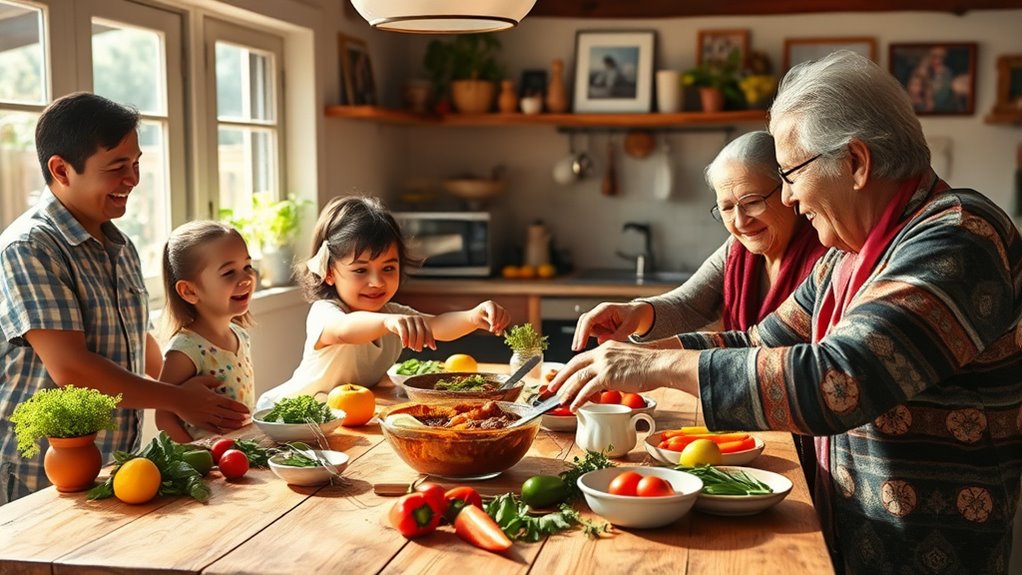Family meal planning and cooking together not only boosts nutritional intake but also strengthens your family’s bonds. By engaging in shared cooking experiences, you foster communication, creativity, and teamwork. Plus, involving everyone in meal choices makes it more enjoyable and healthy. Overcoming busy schedules and picky eaters is easier when you work together. The kitchen becomes a space for connection and tradition. There’s so much more to discover about how food brings families together.
Key Takeaways
- Involve all family members in meal planning to encourage teamwork and enhance enjoyment of shared meals.
- Cooking together fosters communication and creativity, strengthening family bonds while learning valuable skills.
- Schedule regular family meals to build routines that promote emotional stability and well-being.
- Use theme nights and varied recipes to keep meal times exciting and culturally significant.
- Encourage kids to participate in cooking to spark interest in healthier food choices and foster lifelong habits.
The Health Benefits of Family Meals

When you gather around the dinner table as a family, you’re not just sharing food; you’re reaping significant health benefits.
Regular family meals boost your intake of essential nutrients like calcium, vitamins A, C, and E, promoting better nutrition overall. These meals can decrease the likelihood of children developing eating disorders by 35% and cut the risk of being overweight by 12%. Additionally, regular family meals can help shape children’s future eating habits, encouraging them to make healthier food choices as they grow. Creating a supportive environment during meals can also mirror the importance of open communication about feelings, fostering deeper emotional connections.
Eating together also lowers stress levels and depressive symptoms among parents. Plus, kids who join in on family meals are less likely to engage in risky behaviors, fostering healthier habits and cooking skills.
This shared time enhances emotional well-being, making family meals a crucial part of living a healthier, happier life.
Strengthening Bonds Through Cooking Together

Cooking together not only fills your home with delicious aromas but also strengthens family bonds through shared experiences. This teamwork fosters cooperation and communication, making everyone feel included. As you experiment with new recipes, creativity flows, giving you a chance to learn together. The kitchen becomes a relaxed space, encouraging open discussions and emotional connections. The kitchen serves as a classroom for practical skills, allowing family members to learn valuable lessons while enjoying the process. Additionally, cooking together promotes healthy eating habits, which can contribute to the overall well-being of your family. Engaging in meal preparation also allows families to explore home improvement ideas that create a safer and more efficient cooking environment. For example, creating bread pudding from stale bread can be a fun way to reduce waste and enjoy a comforting dessert together. Moreover, cooking as a team helps families understand the importance of cookie categories, which can enhance their overall cooking experience.
Incorporating emotional readiness and communication can also strengthen family dynamics during meal preparation. Completing meals as a team creates lasting memories tied to flavors and special occasions, reinforcing your family identity through cherished traditions. Plus, these collaborative efforts reduce isolation and enhance communication skills. Children develop responsibility and independence, while everyone enjoys the satisfaction of shared achievements, making cooking a joyful and bonding experience for all.
Effective Meal Planning Strategies for Families

Effective meal planning strategies can transform family meal times into enjoyable and stress-free occasions. Start by coordinating schedules to guarantee everyone can gather for meals. Conduct regular inventory checks of your pantry and fridge to avoid overbuying. Incorporate theme nights like Taco Tuesday to keep things exciting. Encourage family involvement by asking for input on meal choices, which boosts enjoyment. Planning and preparation can streamline dinner routines and foster a sense of teamwork among family members.
Plan meals weekly and categorize them for easier organization. Create grocery lists based on these plans to minimize impulse buys. Consider bulk purchasing non-perishables and using ingredients across multiple meals to reduce waste. Finally, set aside designated prep time to streamline your cooking process, making family meals both efficient and fun.
Overcoming Challenges in Family Meal Preparation

Family meal times can be a challenge, especially when juggling busy schedules and various commitments. To overcome these hurdles, planning ahead is essential. Set aside time each week to organize meals and prep ingredients. Simplifying recipes and using meal prep tools like slow cookers can save you precious time. Involve your kids in meal planning, as their participation can spark interest in healthier foods. Address picky eating by incorporating family favorites into your meals, ensuring everyone feels included. Additionally, cooking together encourages family involvement and shared responsibility in the kitchen. For instance, preparing dishes like Turkey Bean and Tomato Zoodle Bowl can make the cooking process both fun and nutritious. Encourage teamwork by assigning age-appropriate tasks to family members, making cooking a fun experience. Furthermore, you can create healthy desserts like frozen yogurt pops, which can be a delicious and refreshing treat for the whole family. Finally, prioritize family meals amidst the chaos; managing your schedules can lead to more shared moments at the table, strengthening your bonds. Moreover, involving kids in meal prep can help them learn about freshly squeezed juices, which can be both a fun activity and a healthier beverage choice. Including options like green juice can enhance their nutritional knowledge and promote healthier eating habits. Additionally, cooking meals together can create opportunities for family bonding, as it fosters communication and teamwork in the kitchen.
The Cultural and Social Significance of Family Meals

While sharing a meal might seem like a simple act, it carries profound cultural and social significance that shapes our connections and traditions. Family meals reflect your heritage, passing down treasured recipes and cooking techniques. They preserve history, ensuring traditions continue through generations. Cooking together can also be a way to embrace the journey to parenthood, strengthening the bonds that will support your family. Additionally, preparing meals using nutritional awareness helps instill healthy eating habits that benefit everyone. Engaging in meal preparation can also enhance self-care routines, allowing families to prioritize their well-being together. Incorporating whole foods into family meals can further promote healthier eating habits.
These shared experiences foster a sense of belonging and community among family members. Regular meals enhance communication and strengthen relationships, creating lasting memories tied to sensory experiences.
Assigning roles during meal prep encourages cooperation, while routines bring predictability, benefiting children’s development. Cooking together teaches nutritional awareness and valuable life skills, preparing kids for independence. Engaging in family meal planning can also improve mental health, offering a platform for positive influences and emotional well-being.
Ultimately, family meals improve mental health, offering a platform for positive influences and emotional well-being.
Frequently Asked Questions
How Can I Involve Picky Eaters in Meal Planning?
To involve picky eaters in meal planning, start by asking them to choose their favorite ingredients or dishes.
Take them grocery shopping, letting them pick new fruits or vegetables that catch their eye.
Encourage them to help with simple cooking tasks, like washing or stirring.
Setting the table together can also make them feel more engaged.
Finally, let them pick a fun theme for dinner to spark excitement around mealtime.
What Are Some Budget-Friendly Meal Planning Tips?
When it comes to budget-friendly meal planning, think of it as an artful dance rather than a chore.
Start by crafting a weekly menu that highlights seasonal produce, ensuring your meals are flavorful and cost-effective. Utilize sales flyers and coupons for great deals, and stick to your shopping list to avoid those tempting impulse buys.
Consider bulk purchases for pantry staples, and repurpose ingredients across meals to minimize waste and maximize savings.
How Often Should We Have Family Meals for Maximum Benefits?
To enjoy maximum benefits, you should aim for family meals three to five times a week. This frequency promotes healthier eating habits, boosts emotional wellness, and strengthens family bonds.
You’ll notice improvements in communication and problem-solving skills, along with a sense of security among family members. Regular shared meals also enhance children’s academic performance and vocabulary, making it an essential practice for both health and development.
What Types of Meals Work Best for Busy Families?
For busy families, quick and convenient meals are key!
Consider one-pot wonders like pasta bakes or skillet sensations that save time and cleanup.
Try air fryer recipes for healthier, hassle-free options, or dump-and-bake dinners that require zero prep.
Slow cooker meals also work well, letting you set it and forget it while you tackle your day.
These strategies guarantee tasty, nutritious meals without adding stress to your schedule!
How Can We Create a Family Meal Tradition?
To create a family meal tradition, start small by designating one meal a week as family time.
Involve everyone in planning the menu, ensuring their favorite dishes are included. Encourage participation by rotating cooking responsibilities and making it fun.
Use this time to share stories and experiences, fostering deeper connections. Gradually increase the frequency as the tradition takes root, and enjoy the bonding moments that come with each shared meal.
Conclusion
In the end, family meal planning and cooking together is like weaving a colorful tapestry of memories and flavors. By sharing the kitchen, you strengthen your bonds and create lasting traditions that nourish both body and soul. Embrace the joy of cooking as a family, tackle meal prep challenges as a team, and savor the health benefits that come with gathered around the table. So roll up your sleeves and let your family’s culinary adventure begin!









